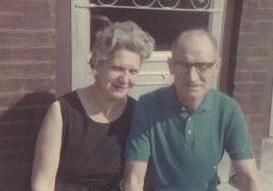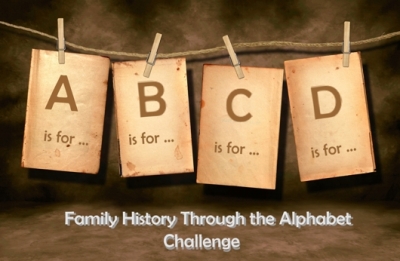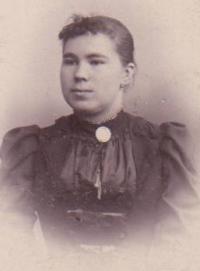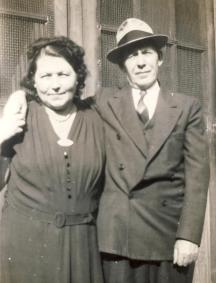The theme for Week 20 of the 2015 edition of the “52 Ancestors in 52 Weeks” challenge is “Black Sheep” and my ancestor is my grandaunt, Jean Piontkowska Hynes.
Black Sheep?
The idiom “black sheep” with regard to genealogy usually refers to an ancestor who did some particularly notorious deed. I guess I should be happy to say that I don’t really have any ancestors that qualify as black sheep by that definition – thankfully there are no murderers or America’s Most Wanted in my family tree. One of my great-grandfathers was convicted of a crime and did a short amount of time in prison, but I don’t know enough about the particulars to tell that story. Another great-grandfather’s brother was wanted for fraud in Germany, but not only have I told that story previously, I’ve also highlighted his brother, sister, and mother so far in this series so by now it would read like a repeat.
So my choice is a different definition…an ancestor, or in this case an ancestor’s sister, who chose a different path. Black sheep are a rare occurrence caused by a recessive gene taking dominance, and not only would a black sheep stand out in the crowd of white sheep but also the black wool could not be dyed and was therefore not valuable. So the term “black sheep” took on a negative connotation. Also interesting is that the idiom appears in several languages besides English, including my ancestral languages of German, Polish, and Czech. But on the surface, an actual black sheep isn’t a bad sheep; they are just different. Rather than highlight the bad seeds from the tree, I’m going to highlight the one who chose a different path and, in so doing, turned her back on her family and never returned.
Jean’s Story
Jean was born as Janina Piątkowska¹ on December 29, 1905 in Warsaw, Poland to Jan Piątkowski and Rozalia Kizeweter. The family lived in the Wola section of the city, and she was baptized at St. Stanisława Church. Janina had an older brother, Józef, who was born two years earlier, and their younger brother (my grandfather) wouldn’t arrive until 1910.
I’ve written about Jean before in November 2010 in a post called “The Sister Who Disappeared” – please take a look to read about the family’s immigration to Philadelphia when Jean was nearly 1 year old. In that post, I detail how Jean disappeared from her family’s lives sometime in the 1920’s. The story my grandfather told was that she, the poor working class daughter of Polish immigrants, met and married a “rich doctor”. The happy couple moved to Florida, never to be heard from again.
Except months after I wrote that post, I found out that Jean was heard from again…just not by my grandfather. I found the 1953 obituary of their brother, Joseph Perk, and it mentioned her name as “Mrs. Jean Hynes”. Finally I had a married name to research! I haven’t uncovered all of the facts of her life, but I know a lot more about her than just knowing her as the sister who disappeared. It turns out my grandfather’s story was almost right. She married the son of a rich doctor, and after living in New York they really did move to Florida.
Sometime around 1926, Jean met and married William Rose Hynes. Or perhaps they met and pretended to be married because I haven’t yet found a marriage license in either Philadelphia or New York. William was born in 1902 in New York City. His father, also named William Rose Hynes, was a doctor who died in 1926. There is a long soap-opera-worthy story in New York newspapers from the 1890s that tell the story of the Hynes’ family wealth and various lawsuits over inheritances. Although young William is listed as a radio engineer in the 1930 census, he did come from a family that had more money than Jean’s immigrant parents. In 1930 the couple lived in an apartment on Broadway, and Jean worked as a hair dresser in a beauty salon.
In 1937, William and Jean lived on 163rd Street, Flushing, Long Island. In November they traveled by ship to Bermuda. While this may not seem exotic by today’s standards, to Jean’s family back in Philadelphia this would have been as exotic as traveling to the moon!
By 1940 the couple is living in Pinellas County, Florida, where William’s uncle also resided. They had no children. That’s when my paper trail ends. But, I was able to find out more about William than about my grandaunt Jean because I discovered that he had a second marriage, a daughter from that marriage, and that he later lived and died just miles from where I live in New Jersey.
According to William’s daughter, he married his next wife in the mid-1940s. She wrote:
There is a family story that they had to elope to MD because he had lived for many years with another woman, and called her his wife, but they had never been formally married. The clerk of courts in Queens refused to give him a license to marry my mother, because he could not produce a divorce decree.
As my grandaunt Jean was that other woman, perhaps she really is a black sheep after all!
William’s daughter was a teenager when he died, so she didn’t know much about his previous relationship. Her mother said that William’s first wife became ill (possibly dying) and he went to visit her and help, perhaps around 1958.
Unfortunately, I don’t know what happened to Jean after her split from William. The obit that led me to research her relationship to Hynes said that she was living in Detroit, and William’s daughter thought she may have lived in New York City, but I’ve been unable to locate a death record in any state so far. I hope to one day find out the rest of Jean’s story.
¹For info on the spelling change to Piontkowska and the present form of my surname, see my grandfather’s profile from Week 15 under the “How Do You Spell That?” theme
Just the Facts
- Name: Jean (Janina) Piontkowska (Piątkowska) Hynes
- Ahnentafel: N/A – grandaunt, sister of #4, my grandfather
- Parents:Jan (John) Bolesław Piątkowski (Piontkowski) (1871-1942) and Rozalia (Rose) Kizeweter (1866-1937)
- Born: 29 December 1905 in Warsaw, Poland
- Siblings: Józef (Joseph) Perk (1903-1953), James Pointkouski (1910-1980)
- Immigrated: from Hamburg, Germany aboard the SS Armenia with her mother and Józef, arriving in New York City on November 9, 1906
- Married: William Rose Hynes III (1902-1966) around 1926; divorced by mid-1940s.
- Children: unknown, at least 5 nieces and 2 nephews
- Died: unknown
Written for the 52 Ancestors in 52 Weeks: 2015 Edition– Week 20: Black Sheep
#52Ancestors
See all of my 52 Ancestors in 52 Weeks stories on the 52 Ancestors page!













